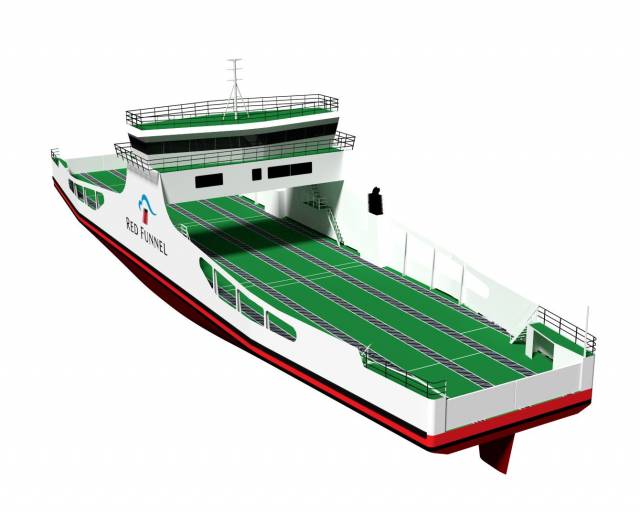#FerryNews - An Irish Sea shipbuilder, Cammell Laird, Birkenhead on Merseyside, has been contracted to build a £10m ro-ro 'freight' ferry for a Isle of Wight operator, Red Funnel
The new ship according to a Red Funnel announcement, is designed to provide additional year-round freight capacity for the Southampton-East Cowes route. The service currently handles 53% of all freight movements across the Solent.
At 74m in length, she will provide 265 lane metres of roll-on/roll-off freight capacity and will carry up to 12 passengers. To minimise the environmental footprint, the hull shape has been designed specifically to reduce wash and a propulsion package has been selected to make her highly fuel efficient whilst meeting the latest Tier III emission regulations. The use of proven azimuth thrusters supplied by Rolls Royce, will also make the ship very manoeuvrable.
The crossing time of 55-60 minutes will be identical to Red Funnel's existing Raptor class ro-pax ships and she will use the same berths in Southampton and East Cowes.
The ship will be constructed at Cammell Laird's famous yard in Birkenhead which built the White Star passenger liner Mauretania in 1938 and HMS Ark Royal in 1955. Currently the yard is building the technically advanced polar research ship Sir David Attenborough for the British Antarctic Survey. The yard is also scheduled to deliver Red Funnel's new ferry in spring 2019.
Kevin George, Chairman and CEO of Red Funnel said "We are the number one operator for cross-Solent freight and this new ship will provide more early morning capacity on weekdays and more freight-only sailings between October and March each year. After a competitive tender, we are delighted to place our third new-build in succession with a UK yard. The order will help sustain marine manufacturing in the UK and will bring benefits to the economy of the North West and also to the Isle of Wight once she enters service."
Business Secretary Rt Hon Greg Clark MP said: "This is another vote of confidence in British shipbuilding and the excellence of our marine manufacturing sector, which we want to build on as part of our Industrial Strategy. Red Funnel continues to grow with this new investment in high quality UK manufacturing. This announcement is great news for the skilled workers at Red Funnel and Cammell Laird, and the local economies of Merseyside and the Isle of Wight".
The order for the new ship, coupled with the major refurbishment of Red Eagle and the order of Red Jet 7, amounts to an investment of over £20m in Red Funnel's cross-Solent services since the business was acquired by the consortium of UK and Canadian pension funds in July 2017. The decisions underpin the new owners' commitment to growing the cross-Solent market and helping to stimulate the Isle of Wight's economy.































































